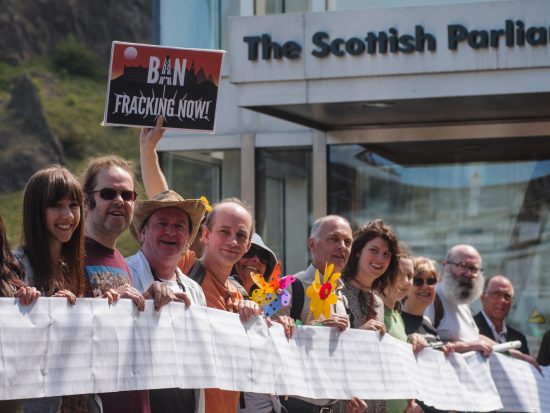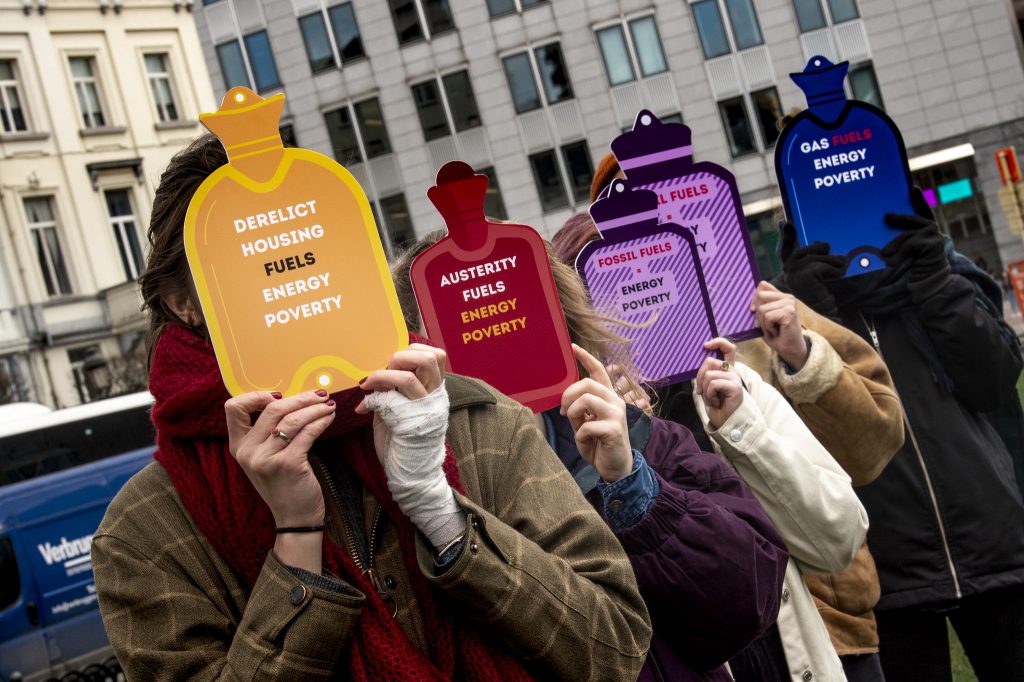Climate emergency is intensifying with glaciers melting at record speed, repeated droughts and floods hitting regions across the EU, most recently in Spain and Italy. The urgency to tackle greenhouse gas emissions is more imperative than ever. On top of this we have seen how fossil gas has been weaponised, threatening energy security and sinking citizens across the EU into energy poverty.
While politicians are getting ready for the 2024 European elections, tackling the climate crisis by shifting away from fossil gas has to become a top priority. The future Commission and new European Parliament will have to ensure continuity of the European Green Deal and pursue measures to deeply cut energy demand, boosting renewable energy, flexibility and circularity measures but most importantly they will need to set the political agenda for phasing out fossil gas in a fair and just way by 2035.
An end date for gas represents a strong incentive for economic actors to plan an orderly shift of current activities and business models away from a system based on fossil fuel consumption. Europe will become stronger through increased energy security and independence while breaking free from the threefold problem fossil gas lock-in represents: the fuelling of the climate crisis, continued fossil fuel dependency and high energy price risk.
1) Principles for a fossil gas phase-out by 2035
2) Deliver EU and national fossil gas phase out plans with intermediate targets, including for methane reduction
3) A climate fund for a just energy transition
4) End domestic and global gas extraction
5) Immediately stop fossil gas infrastructure expansion
6) Planning for an independent and socially just decommissioning of infrastructure
7) No lifetime extension for the fossil gas industry through hydrogen
8) Public finance: Ending fossil-fuel subsidies
9) Private finance: Ensure that financial legislation discourages investments in fossil gas
10) Align EU external relations with the EU gas phase out
Principles for a fossil gas phase-out by 2035. The European Green Deal can only succeed if it aligns the EU’s use of fossil gas with its obligations under the Paris climate agreement aiming at limiting temperature increase to 1.5°C.
- This requires drastic cuts in the EU’s energy demand, halving it by 2040 while fulfilling the remaining energy needs by 100% renewable energy, necessary flexibility, sufficiency and circular economy measures.
- Those measures need to protect and prioritise vulnerable customers, prevent growing energy inequalities and ensure citizens can benefit from the energy transition.
- The EU must put in place provisions to protect decision-making processes and decision-makers from undue influence. To tackle the climate emergency, and ensure that climate policy is conducted entirely in the public interest, we must cut fossil fuel interests out of politics, similar to existing restrictions on the tobacco industry.
Deliver EU and national fossil gas phase out plans with intermediate targets, including for methane reduction. It is crucial that fossil gas phase out objectives are clearly included in the EU’s mid- and long-term climate and energy objectives and include a staged trajectory that delivers an EU wide fossil gas phase out by 2035:
- This trajectory should be aligned to current developments starting from an almost 18% decrease between August 2022 and March 2023 up to 36% by 2025, 60% by 2030 and a full phase out by 2035 according to the Paris Agreement Compatible (PAC) energy scenario[1].
- Intermediate targets for 2025, 2030 and 2035 including sectoral phase out dates for buildings, industry and power should be developed.
- Make the Council’s gas demand reduction measure binding and decouple it from crisis situations. Focus on developing further structural renewables, efficiency and energy demand reduction measures as they will help to relieve people from very high energy prices linked to volatile gas prices.
- On a national level, these objectives should be included in the NECPs. Interesting examples, albeit lacking needed ambition, are the overall Dutch fossil gas phase out by 2050 including a ban on new fossil boilers from 2026 onwards or 100% renewable power targets in Portugal, Denmark and Austria.
- Intermediate targets need also to consider cutting methane emissions, which have contributed as much as 0.5?°C of global warming since pre-industrial times. It is crucial to set a binding target to reduce methane emissions by 75% or higher by 2030 so as to ensure the EU captures the social and environmental benefits. In this regard, Member States must implement national reduction targets as part of their integrated NECPs.
A climate fund for a just energy transition. A climate fund should enable a socially just transition from fossil fuels to sustainable renewables and energy savings, avoiding a lock-in to fossil gas infrastructure and fossil-based jobs. Support should be given to regions, cities and people still dependent on fossil gas, to develop Paris-aligned gas phase out plans and secure adequate financial, material and technical support. This should be the case for common sense technologies such as demand side flexibility measures (e.g. balancing renewables and storage) and key alternatives to fossil gas, which need to be rapidly and widely implemented. But also mature technologies that have experienced shortages during the recent crisis (heat pumps), skilled workforces or electricity grid expansion should receive exponential technical and financial support and be made available to everybody. The fund needs to include strong climate, environmental and social conditionalities in exchange for public support. Crucial focus should lie on the protection of the energy poor or those in risk of energy poverty, while particularly preventing a fossil gas lock-in of vulnerable groups. It is important to ensure they are supported with the switching to alternatives that often have high upfront costs. CAN Europe made suggestions how the EU’s proposed sovereignty fund needs to be adapted to take into account these fundamental preconditions.
End domestic and global gas extraction.
- EU Member States should themselves commit to end fossil gas extraction and join initiatives such as the Beyond Oil and Gas Alliance (BOGA).
- Climate Due Diligence: European companies and investors must end their involvement in fossil gas extraction. This could be achieved by making it mandatory for companies operating on the European market to perform climate due diligence, which would oblige them to screen their value chains for climate risks and mitigate them. This would ensure that companies like Shell, Total and others align their business operations with climate obligations, stop investing in new fossil gas extraction and phase out existing extraction projects.
- Fossil fuel non-proliferation treaty: the fossil fuel non-proliferation treaty initiative is spurring international cooperation to end new development of fossil fuels, phase out existing production within the agreed climate limit of 1.5°C and develop plans to support workers, communities and countries dependent on fossil fuels to create secure and healthy livelihoods. To this day, six governments (Vanuatu, Tuvalu, Fiji, Salomon Islands, Tonga and Niue) have called to negotiate a Treaty, as well as 84 cities and subnational governments and the World Health Organisation.In its resolution outlining its demands for COP27, the European Parliament called on nation-states to “work on developing a Fossil Fuel Non-Proliferation Treaty”.
- The European Union should endorse the Treaty and the European Commission join the list of governments formally seeking a negotiating mandate for a Fossil Fuel Non-Proliferation Treaty and should advocate for countries outside of the EU to endorse the Fossil Fuel Non-Proliferation Treaty
- The EU must push for mentions of fossil fuel fair phase out in international spaces, such as Conference of the Parties (COP) outcome, particularly at COP28, as well as in the Global Stocktake and Mitigation Work Programme.
Immediately stop fossil gas infrastructure expansion. The EU’s gas diversification strategy, as a result of the Russian gas cut off, needs to be addressed to avoid gas lock-in and stranded assets due to LNG and gas transport capacity overexpansion. The EU already had substantial overcapacity before it started diversifying gas supplies and the current trend is in full contradiction with the IEA’s recommendation on halting new infrastructure expansion. Moreover, as the diversification to US LNG, so-called ‘freedom gas’ mostly fracked, has destructive impacts on the environment, climate, and local communities. Some Member States have, for the sake of energy security, largely overestimated LNG infrastructure build out plans such as Germany, but also Poland, France or Italy. The Global Energy Monitor calculated that the EU plans of more than 30 LNG plants would increase the maximum LNG import capacity by 227,7 bcm/y, a potential increase of 136% and add 950 million tonnes of CO2-eq per year.An additional 60.5 bcm/y of gas pipeline import capacity, also proposed on an EU-wide level, would bring the estimated LNG and pipeline infrastructure costs to €53.5 billion. This potential overexpansion would create unneeded costly stranded assets, which are estimated to be mitigated through repurposing for hydrogen only in extremely limited cases, while wrongly risking to stimulate further gas extraction in supply countries. To stop the expansion hype the following steps need to be taken:
- New fossil gas infrastructure including transit infrastructure projects must not be publicly funded (RRF-RepowerEU, CEF, Modernisation Fund etc), and discouraged via legislation to the extent possible,
- Commission fully independent assessments to measure the actual and projected use of infrastructure to stop the expansion and to avoid fossil gas lock in and stranded asset risk.
Planning for an independent and socially just decommissioning of infrastructure. Fossil gas infrastructure does not need to expand any further, and in addition planning for decommissioning of existing infrastructure needs to start quickly. According to the EU Agency for Cooperation of Energy Regulators ACER, gas grid operators are not considering enough options for reducing emissions or decommissioning gas infrastructure in their national development plans to prepare for the energy transition. A recent report on Germany finds that without planned decommissioning and repurposing of gas networks for hydrogen, network operators risk €10 billion in stranded assets with more than 90% of the existing gas networks to become redundant. The following key points should be considered :
- Better regulation of gas transmission and distribution system operators (TSOs and DSOs). The central role and mandates that gas system operators currently enjoy in important energy legislation must be limited to a minimum and be linked strictly to support a just transition out of fossil gas. Infrastructure planning should be independent, including bodies such as the European Scientific Advisory Board on Climate Change (ESABCC) which has been given important responsibilities in terms of future energy infrastructure planning (TYNDP).
- A reliable framework for distribution network planning including public authorities. This could provide clear incentives for decommissioning and significant reductions in gas network utilisation, as gas users disconnect from the gas grid to switch to other heating sources, electrification for instance.
- A fair depreciation of network costs avoiding that costs fall on vulnerable households. A shift to predominantly electrified networks will result in comparatively higher energy system costs and abrupt tariff impacts, those should not be borne by vulnerable consumers.
- Independent Assessments: ACER should recommend how to evolve the subsidy and Regulated Asset Base regime so that it incentivises and supports the network transition (faster depreciation periods, phase out plan for gas subsidies). Independent assessments of network evolution are needed to assess:
- Expected utilisation rates for infrastructure at DSO and TSO level to enable conversation over decommissioning (e.g. via TYNDP/independent ISO or ACER assessment),
- Needs of 100% renewables based hydrogen networks for hard to decarbonise sectors only, to plan for the appropriate infrastructure based on real demand, not on supply possibilities only.
No lifetime extension for the fossil gas industry through hydrogen. Only renewable hydrogen, treated as the scarce, largely inefficient and costly energy vector it is, produced through electrolysis with excess and additional renewable electricity can bring about a climate benefit in line with climate neutrality and the 1.5°C objective of the Paris Agreement. Almost all hydrogen consumed in the EU today is produced with fossil gas.
- Expanding the use of hydrogen, as suggested by the Commission’s REPower EU proposal from May 2022 up to 20 million tonnes of hydrogen (equivalent to 660 TWh, both imported and domestically produced) by 2030 risks very strongly to give the fossil gas industry the perfect excuse for continued fossil gas investments. Thereby creating a lock in effect in contradiction with reaching climate neutrality by 2040 which is what is required to be in line with the 1.5°C objective of the Paris Agreement.
- As a consequence of the changing geopolitical situation many fossil gas infrastructure projects, either already planned or new, have been rebranded as hydrogen ready projects. Furthermore, a large majority of the envisaged hydrogen backbone is dependent on repurposing existing gas pipelines, the feasibility of which is far from clarified. The vast majority of the hydrogen infrastructure projects have been proposed by the fossil gas industry (ENTSOG) and contribute to the lifetime extension of fossil gas use.
- As renewable hydrogen is a scarce and expensive resource, because of conversion losses in its production process, its use needs to be limited to those sectors where direct use of renewable electricity is technically difficult or impossible. Those include energy intensive sectors such as steel and chemicals, which need very high purity levels, or long distance transport such as aviation and shipping. Renewable hydrogen should not be used for a number of applications, eg. to heat homes or for passenger cars justifying for blends of hydrogen and fossil gas thereby incentivising yet again the continued use of fossil gas for instance in hybrid boilers or appliances.
- Standards need to be defined by independent experts to avoid “mixed” solutions such as blending or hydrogen ready pipelines or plants leading to a postponement of a gas phase out and being at consumers’ disadvantage.
Public finance: Ending fossil-fuel subsidies. Fossil gas projects across the full supply chain (from production and extraction, to transport and end use) including hydrogen production from fossil gas and coupled with carbon capture and storage (CCS), also referred to as “blue hydrogen”, should not be eligible for public funding (i.e. REPowerEU, RRF, ERDF, Cohesion Funds, EIB, Hydrogen Bank, Innovation Fund, CEF etc) or any other type of EU or national (state aid) public funding. In line with the International Energy Agency’s recent calls to stop investing in new fossil gas infrastructure and drastically cutting operational emissions in the gas industry and with the EU’s own commitment to end fossil fuel subsidies by 2025. Instead, a climate fund exclusively funding sustainable alternatives should be made available (see point 3). Additionally, regulatory and fiscal incentives need to support reduced fossil gas use and ultimately a fossil gas phase out. The Energy Performance of Buildings Directive (EPBD) must exclude subsidies for fossil gas boilers as currently suggested from 1st of January 2024 onwards in the position of the European Parliament.
Private finance: Ensure that financial legislation discourages investments in fossil gas. The Taxonomy Regulation has been twisted to label private investments into fossil gas and nuclear projects as “green”. Similarly the recent revision of the Renewable Energy Directive led to the inclusion of low carbon hydrogen (i.e. nuclear hydrogen) giving a rebate to the amount of renewable hydrogen to be used in industry by 2030. Wrongly labelling fossil gas or fossil gas-based hydrogen as ‘sustainable’ is greenwashing and must not legitimise the use of these technologies. Private investments in new fossil gas infrastructure must be discouraged.Any investments that are still being made in new fossil gas exploration, extraction and transport infrastructure, are to become stranded assets if Europe is to meet the 1.5°C objective of the Paris Agreement. This means that those investments at some point will lose most or all of their value, which creates a systemic risk for banks, insurers, pension funds and other financial institutions, particularly those who have disproportionately invested in gas and other fossil fuel projects. To mitigate this risk, the EU should introduce a “one-for-one” rule for the capital requirements applicable to financial institutions in EU legislation (CRD/CRR and Solvency II) and the related global standards, so that every single euro invested in new fossil [fuel/gas] projects will have to be fully backed by the institution’s own capital, to correctly reflect the individual and systemic risk attached to the investment. This will in consequence shield governments and therefore people and taxpayers from having to bear the cost of losses incurred for such projects and avoid a ‘Climate Lehman Brother’ moment.
Align EU external relations with the EU gas phase out. The EU Foreign Affairs Ministers have already agreed to “systematically promote and call for a global move towards energy systems free of unabated fossil fuels well ahead of 2050”. The EU needs to align its external relations with its own gas phase-out trajectory and seize the economic and energy security benefits from clean energy focussed global relationships. The recent increase of LNG imports in Europe is currently pushing for the opposite, with Egypt burning dirtier fuels such as mazut, a low quality heavy fuel oil, to export more gas to Europe. To get on track, the following criteria need to be conditional for continued partnerships :
- Aligning existing contractual relationships on fossil gas imports via long term contracts with the EU’s phase out trajectory, e.g. by setting an end date for Long Term Contracts (LTCs) by 2035 at the latest. The length of these LTCs should not exceed 5 years and stop by 2035. Those contracts should ensure that the EU only imports fossil gas which applies strong methane emission reduction measures (such as those adopted by EU legislators).
- The EU should tailor its energy and economic partnerships with producer or transit countries of fossil gas in line with its phase out trajectory by 2035 while supporting them on economic transition strategies through finance and technology transfer.
- Consistent with the IEA’s analysis of a global net-zero pathway, no new upstream developments are necessary and should thus not be supported. In countries where fossil gas demand is high or likely to increase, partnerships should assess demand drivers and support the country to access alternatives.
- The EU and its Member States must also ensure that fossil fuel companies cannot sue governments for compensation in relation to stranded assets. To this end, trade and investment agreements that contain Investor-State Dispute Settlement (ISDS) must be scrapped or thoroughly revised. The reform of the Energy Charter Treaty (ECT), however, has even expanded rather than curtailed investment protection for new fossil gas and gas-derived hydrogen investments. The EU and all Member States must therefore not greenlight the reform but exit the ECT with immediate effect.
Signed by:

[1] Please take note that these figures are being updated in the context of the second phase modelling of the PAC scenario, they are compared to 2015 levels.
Related Content
We think you’d also like:

Gas
Stopping climate breakdown means keeping all fossil fuels in the ground – including gas. Governments and banks must stop financing gas pipelines and terminals which would lock us into a fossil-fuel future.







